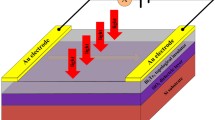Abstract
A model for a polycrystalline semiconductor corresponding to its real structure is proposed. On the basis of this model, a mechanism for anomalous photovoltaic effects (the initiation of an anomalous photovoltage, its dependence on illumination angle, and anomalous photomagnetic effect) is developed. It is assumed that potential barriers introducing inhomogeneity into the spatial distribution of photocarriers arise due to the capture of majority charge carriers at surface states of the crystallite boundaries. The effect is heavily dependent on the barrier height: if the band bending at the crystallite boundaries is depleting, the effect is determined by the spatial separation of the majority photocarriers by the barrier; otherwise, (the inversion band bending) the effect is formed due to the separation of minority photocarriers. The basis for the mechanism is the anisotropy of light absorption in the polycrystal’s bulk (the depleting band bending) or the geometrical inhomogeneity of the films caused by oblique deposition during fabrication (the inversion band bending.) The cause of the anisotropic absorption of light is its reflection by crystallite boundaries.
Similar content being viewed by others
References
T. Starkievich, L. Sosnowski, and O. Simpson, Nature 158, 26 (1946).
L. Pensak and B. Goldstein, Phys. Rev. 109, 601 (1958).
E. I. Adirovich, Usp. Fiz. Nauk 105, 746 (1971).
E. I. Adirovich et al., in Photoelectrical Phenomena in Semiconductors and Optoelectronics, Collected vol. (FAN, Tashkent, 1972) [in Russian].
L. Pankove, Phys. Status Solidi A 61, 127 (1980).
G. A. Nabiev, Semiconductors 43, 894 (2009).
V. N. Agarev and N. A. Stepanova, Semiconductors 34, 438 (2000).
K. M. Doshchanov, Sov. Phys. Semicond. 24, 788 (1990).
K. M. Doshchanov and V. D. Sokolov, Sov. Phys. Semicond. 24, 882 (1990).
H. Kallman, B. Kramer, E. Haidemenakis, W. I. McAller, H. Barkemayer, and P. E. Pollak, J. Electrochem. Soc. 108, 247 (1961).
F. T. Novik, Sov. Phys. Solid State 4, 2440 (1962).
V. G. Schwabe. Z. Naturforsch. 10a, 78 (1955).
V. N. Ovsyuk, Sov. Phys. Semicond. 2, 992 (1968).
P. P. Konorov, K. Lyubitts, and I. Ortler, Uch. Zap. Len. Gos. Univ. 336, 98 (1968).
R. Ya. Berlaga, T. T. Bykova, et al., Uch. Zap. Len. Gos. Univ. 336, 92 (1968).
Sh. B. Atakulov, Solid State Commun. 51, 415 (1984).
Sh. B. Atakulov, Sov. Phys. Semicond. 18, 1162 (1984).
L. N. Neustroev and V. V. Osipov, Sov. Phys. Semicond. 20, 34 (1986); Sov. Phys. Semicond. 20, 38 (1986).
L. Kazmerski, in Polycrystalline and Amorphous Thin Films and Devices, Materials Science and Technology Series (Academic Press, New York, 1980; Mir, Moscow, 1983).
Sh. B. Atakulov and I. M. Kokanbaev, Thermal and Radiation-Induced Processes in Polycrystalline Films of Lead Chalcogenides (FAN, Tashkent, 1992) [in Russian].
E. Z. Meilikhov, Phys. Usp. 36, 129 (1993).
A. N. Orlov, in Atomic Structure of Intergrain Boundaries (Mir, Moscow, 1978), p. 5 [in Russian].
E. F. Pocza, Acta Phys. Acad. Sci. Hung. 15, 89 (1968).
Ya. E. Geguzin, Outline of Diffusion in Crystals (Nauka, Moscow, 1970) [in Russian].
D. S. Campbell, in Handbook of Thin Film Technology, Ed. by L. Maissel and R. Glang (McGraw-Hill, New York, 1970; Radio, Moscow, 1977).
V. A. Pogrebnyak, V. M. Yakovenko, and I. V. Yakovenko, Phys. Solid State 39, 1765 (1995).
N. K. Borodkina and L. P. Strakhov, Sov. Phys. Solid State 8, 1803 (1966).
Author information
Authors and Affiliations
Corresponding author
Additional information
Original Russian Text © Sh.B. Atakulov, S.M. Zainolobidinova, G.A. Nabiev, O.A. Tukhtamatov, 2012, published in Fizika i Tekhnika Poluprovodnikov, 2012, Vol. 46, No. 6, pp. 728–733.
Rights and permissions
About this article
Cite this article
Atakulov, S.B., Zainolobidinova, S.M., Nabiev, G.A. et al. Effect of the structural features of polycrystalline semiconductor films on the formation of anomalous photovoltage: I. Phenomenon mechanism. Semiconductors 46, 708–713 (2012). https://doi.org/10.1134/S1063782612060036
Received:
Accepted:
Published:
Issue Date:
DOI: https://doi.org/10.1134/S1063782612060036




